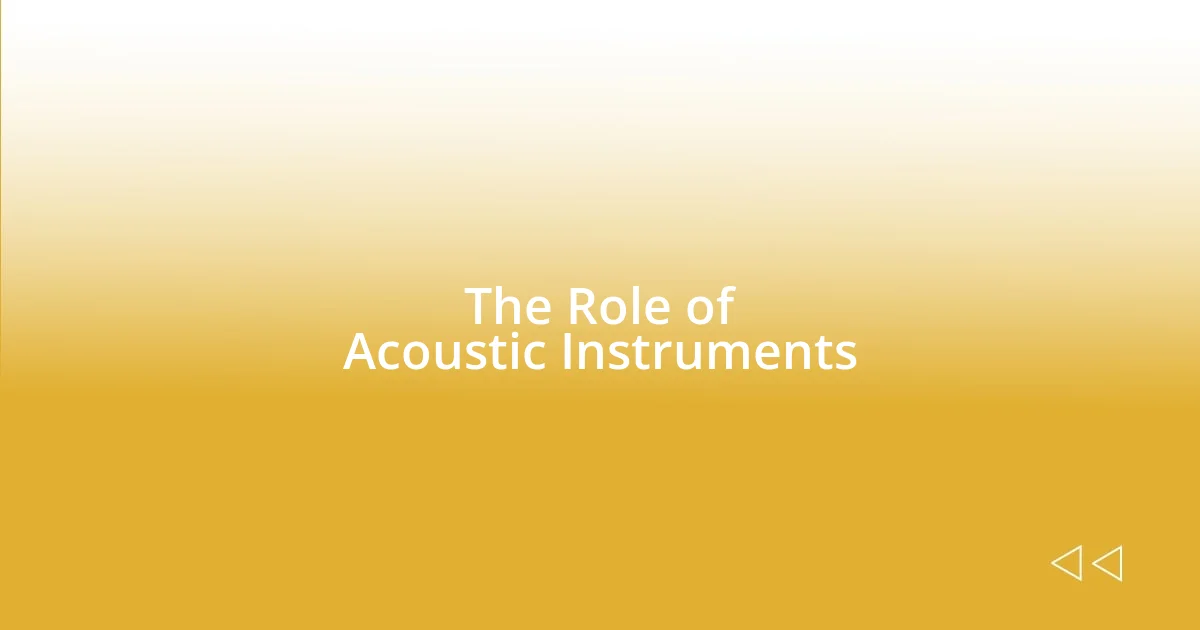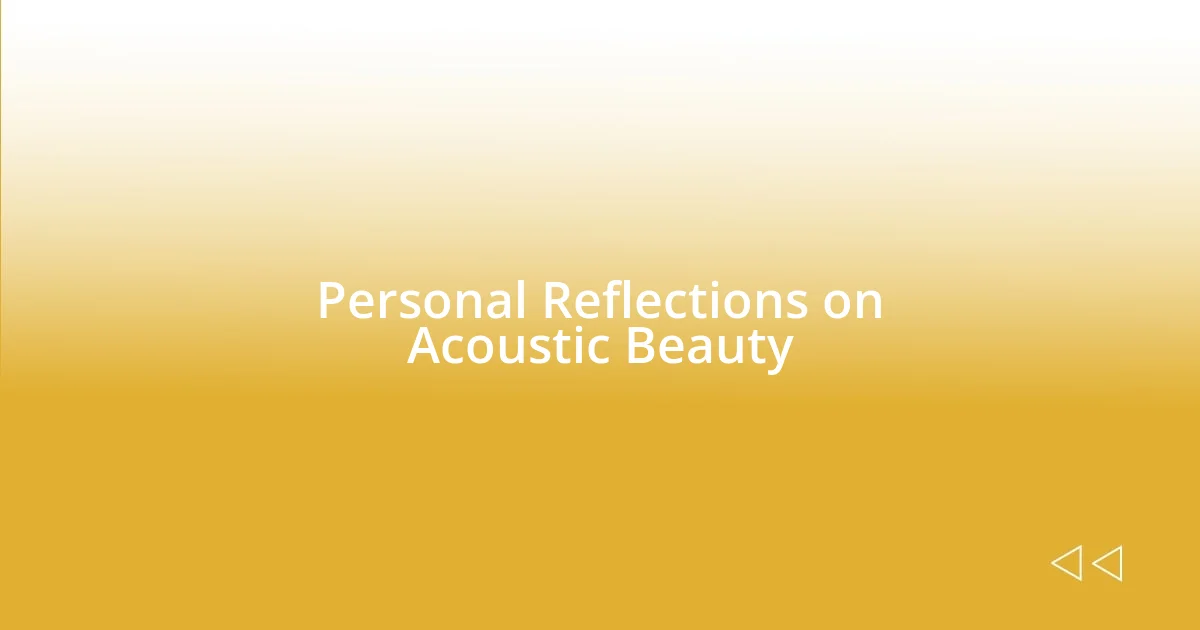Key takeaways:
- Acoustic beauty combines sound quality with emotional connection, where subtle imperfections in performance enhance the experience.
- Creating the right environment, through quiet spaces and thoughtful arrangements, significantly impacts the appreciation of acoustic sound.
- Acoustic instruments foster emotional expression and collaboration, amplifying individual artistry while creating bonds among musicians and audiences.

Understanding Acoustic Beauty
Acoustic beauty, to me, is a blend of sound quality and emotional resonance. I remember the first time I heard a live acoustic guitar performance in a small café. The way the notes vibrated in the air, creating an intimate atmosphere—it felt like the music was wrapping around me, pulling me into that moment. Have you ever felt that connection when you listen to something raw and stripped down?
When I delve into the essence of acoustic beauty, I find it’s more than just the sound itself; it’s the space it occupies. The natural reverberation of a room can transform a simple melody into something breathtaking. I’ve often noticed how a well-placed pause can add depth to a song, letting the silence speak just as loudly as the notes. Don’t you agree that sometimes, it’s those little nuances that can elevate our listening experience dramatically?
Moreover, understanding acoustic beauty involves recognizing the imperfections that make music authentically human. There’s something wonderfully imperfect about a singer slightly straying off-pitch or a guitar string that doesn’t quite ring true. These moments remind me of the beauty in vulnerability—how they draw us closer to the artist’s intention. Have you ever listened to a live recording and felt those raw emotions stir within you? That’s acoustic beauty at its finest: real, relatable, and utterly captivating.

Techniques for Appreciating Acoustic Sound
Recognizing the subtleties in acoustic performances can greatly enhance our appreciation of sound. I’ve found that listening in a quiet space, free from distractions, allows the resonance of each note to resonate within. One evening, I turned off all devices and simply listened to a vinyl record of my favorite acoustic album. The depth of sound and the way it filled the room was almost meditative—do you ever take a moment to just listen deeply?
A significant technique for appreciating acoustic sound is to focus on the environment where the music is played. Different settings lend unique qualities to performances. I recall enjoying a sunset concert under the open sky, where the natural ambient sounds blended harmoniously with the music, creating an unforgettable experience. It made me realize how important the physical space is in shaping our emotional responses to acoustic music.
Moreover, employing active listening can elevate your enjoyment. By consciously engaging with the music, you can discern the intricate details, like the subtle fingerpicking on a guitar or the breath control of a vocalist. One night, while attending a local open mic, I made it a point to close my eyes and focus solely on the sounds. Each artist’s interpretation felt personal, as if they were sharing their stories directly with me. Have you given yourself the chance to fully absorb and reflect on acoustic performances?
| Technique | Description |
|---|---|
| Quiet Listening | Engage in a distraction-free environment to enhance sound quality. |
| Environment Awareness | Consider how different settings impact the acoustic experience. |
| Active Listening | Focus on details within the music to deepen appreciation. |

The Role of Acoustic Instruments
The beauty of acoustic instruments lies in their ability to convey emotions that digital sounds often struggle to replicate. I still remember the first time I plucked the strings of my grandfather’s old acoustic guitar. The warmth of the wood and the rich, natural tones created a sense of nostalgia that resonated deep within me. Each chord felt like a connection to generations past, transporting me back to family gatherings filled with laughter and music. Isn’t it intriguing how acoustic instruments can evoke such powerful memories?
- Emotional Connection: Acoustic instruments have an innate ability to stir emotions, providing a personal touch that electronic sounds often lack.
- Natural Sound Quality: The resonance produced by acoustic instruments creates a unique soundscape, enhancing the listening experience.
- Cultural Significance: Many traditional music styles heavily rely on acoustic instruments, reflecting cultural heritage and history.
When I think about the role of acoustic instruments, I also consider how they often encourage collaboration and connection between musicians. I once joined a small jam session in my neighborhood, where everyone brought their acoustic instruments. The synergy we created together was beyond words; each strum and beat echoed our shared passion for music. There’s something magical about strumming a guitar or tapping a cajón in harmony that transforms individuals into a cohesive group, isn’t there? That’s the beauty of acoustic instruments—they invite us to create, share, and connect.
- Collaborative Spirit: Acoustic instruments facilitate spontaneous music-making and camaraderie among musicians.
- Accessibility: They are often more portable and accessible, making music creation easier in varied settings.
- Expression of Individuality: Each instrument brings forth the player’s unique style and personality, highlighting individual artistry.

Creating Acoustic Spaces
Creating an acoustic space is all about tuning into the environment we choose for our listening. I recently transformed my small living room into a cozy acoustic haven by rearranging some furniture. I moved the couch closer to a few strategically placed plants. Surprisingly, the way sound bounced off the walls and blended with the subtle rustling of the leaves made each note feel alive. Isn’t it fascinating how the smallest changes can elevate our auditory experiences?
Another aspect I cherish is lighting. When I dimmed the lights and lit a couple of candles, the atmosphere shifted dramatically during my last listening session. The warm glow created an inviting context that made even the simplest acoustic guitar performance feel profound and intimate—almost as if the artist was performing just for me. Can you remember a time when the ambiance complemented the music in such a way that it lingered in your heart long after the last note?
I’ve discovered that incorporating natural materials into the space can enhance sound quality, too. The wooden shelves I built not only serve as a place for my vinyl collection but also contribute to the room’s acoustics. The rich textures create a warm resonance that enriches the listening experience. Have you experimented with your space in a way that amplifies the beauty of acoustic sound?

The Impact of Acoustic Quality
The impact of acoustic quality is something I’ve come to appreciate profoundly over the years. I remember attending a small concert in a local café where the artist performed with nothing but an acoustic guitar. The clarity of the sound was astounding; every strum felt tangible, piercing right through the chatter of the audience, creating an almost sacred atmosphere. Have you ever experienced a moment where the music seemed to wrap around you, making everything else fade away?
Quality acoustics don’t just enhance our enjoyment; they shape the very experience of listening. I once installed a few acoustic panels in my home studio, and the difference was remarkable. Suddenly, every note I played on my guitar resonated beautifully, allowing me to hear nuances I’d never noticed before. It felt as if my music had been waiting for the right space to express itself fully. Isn’t it amazing how the right environment can amplify the magic of sound?
Moreover, I’ve noticed that the emotional connection to music deepens when the acoustics are right. While having friends over for a jam session, we shared songs in a small, acoustically-friendly room. The energy was electric! Each chord struck brought us closer, the sound swirling around us like a warm embrace. This experience reminded me that great acoustic quality is not just about clarity; it’s about creating an atmosphere where music can truly communicate and resonate with our souls. How often do you find yourself enchanted by the acoustics of a place?

Tips for Enhancing Acoustic Experience
To truly enhance your acoustic experience, consider the power of soft furnishings. In my own living room, I tossed a few plush pillows and added a thick rug beneath my listening area. The difference was immediately noticeable—the sound felt cushioned and warm, wrapping around me like a cozy blanket. Have you ever tried using textiles to shape the acoustics in your space? It’s a simple yet effective way to elevate your listening sessions.
Another tip is to experiment with your sound sources. I often switch between vinyl, digital, and even live streaming, each offering a different texture to the sound. Recently, I played my favorite album on vinyl and was struck by a level of depth and warmth that my digital library hadn’t been able to replicate. Isn’t it incredible how the medium can shape our emotional response to music? Pay attention to these nuances because they can completely transform your acoustic experience.
Lastly, I find that tuning into the moment is essential. I once invested in a high-quality set of headphones and was amazed at how they isolated every note, making each listening session feel like a personal concert. Sitting quietly, with my eyes closed, I could almost visualize the artist’s emotions pouring through each strum or beat. When was the last time you truly listened—body and soul—to a piece of music? That mindfulness can be the key to unlocking the full beauty of acoustic sound.

Personal Reflections on Acoustic Beauty
I often find myself reflecting on how acoustic beauty transforms even the simplest moments. Just last week, I sat outside on my porch, strumming my guitar as the sun began to set. The sound carried softly into the evening air, mingling with the rustling leaves. It struck me how an acoustic performance can turn solitude into something profoundly beautiful—almost like an intimate conversation with nature. Have you ever felt that connection between music and the world around you?
One of my fondest memories is of a small music festival in a park. Musicians played under a canopy of trees, their acoustic melodies weaving through the crowd. As I closed my eyes, I felt completely enveloped by the music, the natural reverb enhancing each note. It made me realize how distance and environment can amplify our experiences. How does music shape your surroundings?
Every time I listen to a live acoustic set, I’m hit by the realization that the beauty lies not just in the sound, but in the shared experience. There’s something incredibly special about witnessing an artist reveal their soul through music. I remember a night at a friend’s house, everyone gathered around as one of our friends played a heartfelt ballad. The room felt electric, and it seemed as if everyone was connected through those sounds. Isn’t it fascinating how live acoustic music can create an unspoken bond among strangers?













